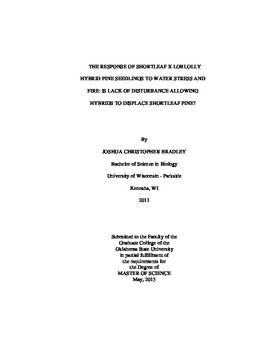| dc.contributor.advisor | Will, Rodney E. | |
| dc.contributor.author | Bradley, Joshua Christopher | |
| dc.date.accessioned | 2016-09-29T18:31:56Z | |
| dc.date.available | 2016-09-29T18:31:56Z | |
| dc.date.issued | 2015-05-01 | |
| dc.identifier.uri | https://hdl.handle.net/11244/45141 | |
| dc.description.abstract | Shortleaf pine (Pinus echinata Mill.) is a hardy pine species. It possesses the widest range of any southern pine and once covered millions of hectares of the southern United States. Loblolly pine (Pinus taeda L.) is the most commercially important species in the south with over a billion seedlings planted annually. Logging, land use change, fire exclusion, and other factors have led to a significant decline of shortleaf pine across much of its former range. Among the threats to shortleaf pine is a sudden increase in the number of shortleaf x loblolly hybrid pines in the seedling cohort. The presence of a hybrid swarm is alarming because the hybrid pine can a) outgrow shortleaf pine and b) interbreed with shortleaf pines, threatening shortleaf pine's genetic integrity. While shortleaf and loblolly pines are well studied, the characteristics of the hybrid pine are less known. The traits that may be responsible for the hybrid pine's sudden increase in the last 60 years are particularly interesting. I tested the importance of the basal crook to shortleaf pine's fire tolerance. I also tested shortleaf, hybrid pine, and loblolly pine seedlings' response to water stress by measuring allometry and transpiration under well watered and water stressed conditions. Finally, I tested the shortleaf, hybrid, and loblolly pine seedlings response to fire. The basal crook (which the hybrid pine lacks) was shown to be a crucial morphological feature - shortleaf cannot resprout after fire without it. Shortleaf, hybrid pine, and loblolly pine seedlings were similar in most allometric measurements. However, shortleaf pine possessed greater coarse root biomass and loblolly pine possessed greater stem biomass. I did not find any differences in regulation of transpiration between the three species. In the fire studies, shortleaf pine seedlings were far more successful at resprouting after fire than hybrid pine or loblolly pine seedlings. These results lead us to conclude that the rapid increase in the numbers of hybrid pine is likely due to the exclusion of fire. Reintroducing fire will reduce the number of hybrid pines seedlings and restore shortleaf pine. | |
| dc.format | application/pdf | |
| dc.language | en_US | |
| dc.rights | Copyright is held by the author who has granted the Oklahoma State University Library the non-exclusive right to share this material in its institutional repository. Contact Digital Library Services at lib-dls@okstate.edu or 405-744-9161 for the permission policy on the use, reproduction or distribution of this material. | |
| dc.title | Response of Shortleaf X Loblolly Hybrid Pine Seedlings to Water Stress and Fire: Is Lack of Disturbance Allowing Hybrids to Displace Shortleaf Pine? | |
| dc.type | text | |
| dc.contributor.committeeMember | Wilson, Duncan | |
| dc.contributor.committeeMember | Doust, Andrew | |
| osu.filename | Bradley_okstate_0664M_14016.pdf | |
| osu.accesstype | Open Access | |
| dc.description.department | Natural Resources and Ecology Management | |
| dc.type.genre | Thesis | |
